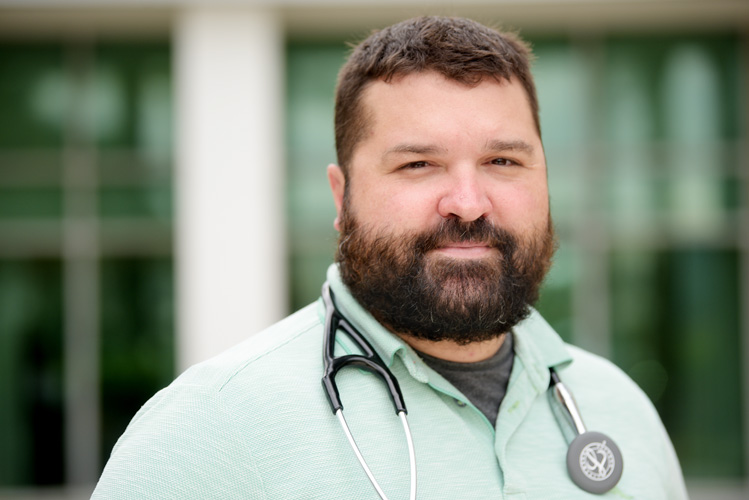
Breathing is the most natural thing in the world, an act that most of us do without a second thought. But if breathing is impaired and labored because of a lung or respiratory illness, it becomes the most important lifeline of all. When complications arise from the windpipe to the lungs, the intervention of a good pulmonologist could be the difference between life or death.
Dr. Justin Hunsucker, a critical care pulmonologist with Cleveland Clinic Martin Health, entered the field because he loved problem solving. “I wanted to specialize in something where I was challenged at work and one that would require me to keep learning,” he explained.
“I was leaning toward internal medicine and loved working in ICU so I decided to specialize in pulmonary medicine, where I focus on diagnosis and management of disorders of the respiratory system, including the lungs, upper airways, thoracic cavity and chest wall.”
Dr. Hunsucker joined the team at Cleveland Clinic in July 2019, moving down from West Virginia after completing his medical education and training at West Virginia University and University of Louisville schools of medicine. “A mentor of mine from med school had joined the team and he recruited me. I jumped at the opportunity to be part of Cleveland Clinic family and quite frankly couldn’t wait to get out of the cold,” Dr. Hunsucker said.
Most of Dr. Hunsucker’s patients come in with a persistent cough or shortness of breath. The majority are diagnosed with COPD (chronic obstructive pulmonary disease) or asthma, but he also treats cancer, pneumonia, pleurisy, bronchitis, sleep disorders, emphysema, tuberculosis, chest infections and complex disorders of the lungs.
“Most of the time COPD and asthma are treated with inhalers, although more severe cases are sometimes referred to Pulmonary Rehab, where the patient receives physical therapy from a respiratory therapist to increase their stamina through exercise,” said Hunsucker. “The exercises basically boost the mechanics of breathing, and while they don’t improve the numbers of pulmonary functions, they do improve the patient’s quality of life by enabling them to get up and moving again.”
Severe and end stages of COPD require the use of portable oxygen when the patient is walking. As the disease progresses, patients eventually require oxygen 24 hours a day to breathe. Because smoking-related diseases generally affect both lungs, surgery is not an option and managing the symptoms is the only course of action.
“We’re actually born with twice as much lung as needed, so if a disease is confined to one lung there are surgical options,” explained Hunsucker. “If malignant pulmonary nodules develop on just one lobe, lung volume reduction surgery done by a thoracic surgeon is an option. It’s even possible to remove one lung. As long as the other lung is in decent shape, the patient would be able to function as well as anyone in the general population. Unfortunately, most smoking related diseases affect both lungs.”
Cleveland Clinic has a multidisciplinary tumor board comprised of all the doctors involved with treating lung cancer. Radiologists, pathologist, thoracic surgeons, oncologists and pulmonologists gather to discuss the best treatment for the patient. “The team approach allows for open communication among the specialists and ensures the most beneficial treatment for the patient,” continued Hunsucker.
“Screening for folks at risk is very important,” he added. “Most lung cancers don’t cause any symptoms until they’ve grown quite large. If we can catch them in the early stages, we can actually operate – which is curative versus catching them later when all we can do it try to get it into remission.”
It’s advised that active smokers who have smoked the equivalent of a pack a day for 30 years or two packs a day for 15 years start screening at age 55.
A simple ultrasound procedure will generate a sonogram giving the physician a picture of what’s going on in the lungs. The survival rate for stage 1 lung cancer is 90 percent as opposed to only a 10 percent or less survival rate for later stages, so the earlier the disease is diagnosed the better the chances of survival.
COVID has introduced a whole new set of problems for respiratory systems. “We are seeing patients who were free of respiratory symptoms, with no pre-existing conditions, become sick enough to require oxygen in the hospital,” said Hunsucker. “They get better, leave and come back for a follow-up visit a few months later, only to find scarring on their lungs. Unlike everyday bacterial infections like pneumonia, which typically attack only one lobe leaving the healthy lobe to pick up the slack, COVID patients have scarring on both sides.
“It randomly attacks, as well. We see healthy patients in their 30s and 40s on ventilators for weeks, and people in their 70s and 80s who are treated with medicine and go home. It’s been a very humbling experience, and six months into the pandemic we are still learning.”
So far, the Treasure Coast hasn’t been in danger of running out of intensive care beds for COVID patients, although the ICU has been busy.
When Dr. Hunsucker isn’t working in the ICU or treating patients, he enjoys spending time at his home in Palm City with his wife and two dogs. “I enjoy fishing and deer hunting and I’m the primary cook in the family.”
When asked what the No. 1 thing people can do for good health, he quickly answered: “Don’t smoke. Or stop smoking immediately. In addition to saving your lungs and your ability to breathe, it also reduces the risk of strokes and increases life expectancy.”



